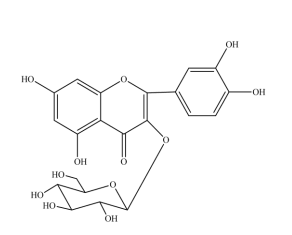Home
Products
Isoquercitrin



| Product Name | Isoquercitrin |
| Price: | $31 / 20mg |
| Catalog No.: | CN05347 |
| CAS No.: | 482-35-9 |
| Molecular Formula: | C21H20O12 |
| Molecular Weight: | 464.4 g/mol |
| Purity: | >=98% |
| Type of Compound: | Flavonoids |
| Physical Desc.: | Yellow powder |
| Source: | The herbs of Prunella vulgaris L. |
| Solvent: | DMSO, Pyridine, Methanol, Ethanol, etc. |
| SMILES: | OC[C@H]1O[C@@H](Oc2c(oc3c(c2=O)c(O)cc(c3)O)c2ccc(c(c2)O)O)[C@@H]([C@H]([C@@H]1O)O)O |
| Contact us | |
|---|---|
| First Name: | |
| Last Name: | |
| E-mail: | |
| Question: | |
| Description | Quercetin-3-glucoside is a naturally occurring polyphenol that has antioxidant, anti-proliferative, and anti-inflammatory properties.Quercetin-3-glucoside alleviates ethanol-induced hepatotoxicity, oxidative stress, and inflammatory responses via the Nrf2/ARE antioxidant signaling pathway[1].Quercetin-3-glucoside regulates the expression of nitric oxide synthase 2 (NO2) via modulating the nuclear factor-κB (NF-κB) transcription regulation system. Quercetin-3-glucoside has high bioavailability and low toxicity, is a promising candidate agent to prevent birth defects in diabetic pregnancies[2]. |
| In Vitro | Quercetin-3-glucoside (5-20 μM; 24 hours) substantially reduces ethanol-induced cytotoxicity , protects hepatic cells against ethanol‐stimulated liver injury[1].Quercetin-3-glucoside (10 μM; pre-treat 1 hour) dramatically downregulates the levels of ethanol-induced iNOS protein expression in HepG2 cells[1]. Cell Viability Assay[1] Cell Line: HepG2 cells Concentration: 5 μM, 10 μM, 20 μM Incubation Time: 24 hours Result: Caused significantly enhanced cell viability as positive controls. Western Blot Analysis[1] Cell Line: HepG2 cells Concentration: 10 μM Incubation Time: 1 hour Result: Decreased ethanol‐ induced iNOS protein expression. |
| Density | 1.9±0.1 g/cm3 |
| Boiling Point | 872.6±65.0 °C at 760 mmHg |
| Flash Point | 307.5±27.8 °C |
| Exact Mass | 464.095490 |
| PSA | 210.51000 |
| LogP | 1.75 |
| Vapour Pressure | 0.0±0.3 mmHg at 25°C |
| Storage condition | −20°C |